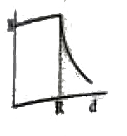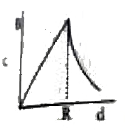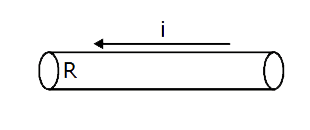The current density across a cylindrical conductor of radius R varies in magnitude according to the equation J=J0(1−rR) where r is the distance from the central axis. Thus, the current density is a maximum J0 at that axis (r=0) and decreases linearly to zero at the surface (r=R). Calculate the current in terms of J0 and the conductor's cross - sectional area A=πR2.
J0A3
J0A6
2J0A3
J0A5
The correct Answer is:C
J=J0(rR)
di = JDA = J (2πrdr)
i=∫R0J0(rR)2πrdr
i=2πJ0[R33R]=(2J0A3)
Topper's Solved these Questions
Similar Questions
The current density in a cylindrical conductor of radius R varies according to the equation J=J0(1−rR), where r=distacnce from the axis. Thus the current density is a maximum J0 ata the axis r=0 and decreases linealy to zero at the srface r=2√π. Current in terms of J0 is given by n(J06) then value of n will be.
View SolutionSuppose that instead the current density is a maximum J0 at the surface and decreases linearly to zero at the axis so that J=J0rR. Calculate the current.
View Solution
Knowledge Check
The current density is a solid cylindrical wire a radius R, as a function of radial distance r is given by J(r)=J0(1−rR) . The total current in the radial regon r = 0 to r=R4 will be :
A5J0πR232B5J0πR296C3J0πR264DJ0πR3128A cylindrical wire of radius R has current density varying with distance r form its axis as J(x)=J0(1−r2R2) . The total current through the wire is
AπJ0R22B2πJ0R23C4πJ0R23Dnone of theseA cylindrical conductor of radius R is carrying constant current. The plot of the magnitude of the magnetic field, B with the distance, d from the centre of the conductor , is correctly represented by the figure:
A B
B C
C D
D
A current is flowing through a cylinderical conductor of radius R, such that current density at any cross-section is given by J=J0(1−rR), where r is radial distance from axis of the cylinder .Calculate the total current through the cross-section of the conductor.
View SolutionIf the current density in a linear conductor of radius 'a' varies with r according to relation J=kr2, where k is a constant and r is the distance of a point from the axis of conductor. Find the magnetic field induction at a point distance r from the axis, when (i) r<a and (ii) r>a.
View SolutionSuppose that the current density in a wife of radius a varies with r according to J=Kr2, where K is a constant and r is the distance from the axis of the wire. Find the megnetic field at a point distance r from the axis when (a) r < a and (b) r > a

View SolutionThe mass density of a planet of radius R varie with the distance r form its centre as ρ(r)=p0(1−r2R2). Then the graviational field is maximum at :
View SolutionA long cylindrical conductor of radius R carries I as shown. The current density is a function of radius r as j = br, where b is a constant. The magnetic field at a distance r1(r1<R) is

View Solution

